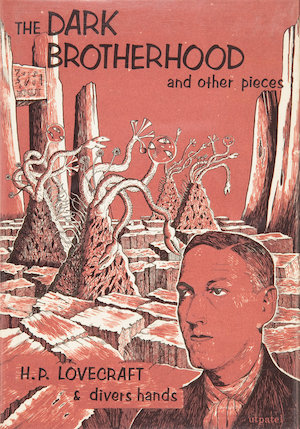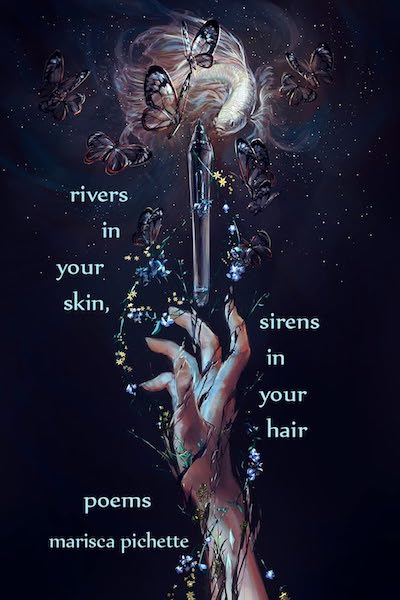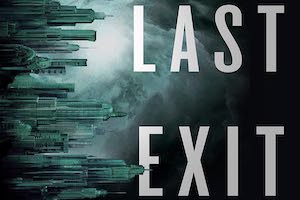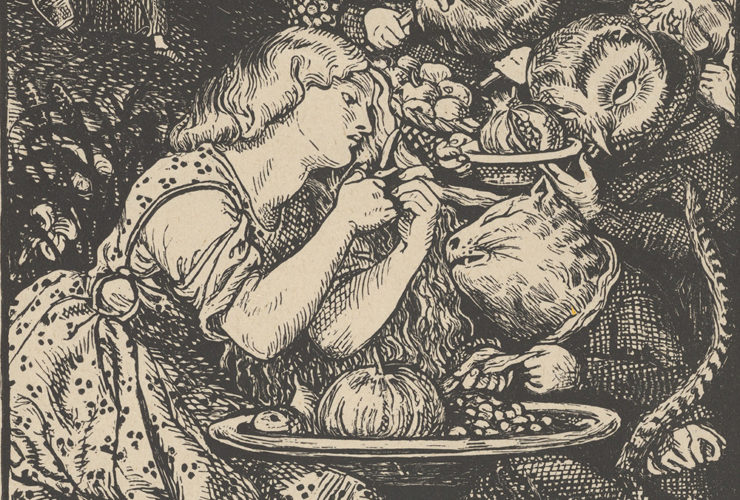Welcome back to Reading the Weird, in which we get girl cooties all over weird fiction, cosmic horror, and Lovecraftiana—from its historical roots through its most recent branches.
This week, we cover Fritz Leiber’s “To Arkham and the Stars,” first published in 1966 in Arkham House’s The Dark Brotherhood. Spoilers ahead.
“…after you’ve spent an adult lifetime at Miskatonic, you discover you’ve developed a rather different understanding from the herd’s of the distinction between the imaginary and the real.”
Our unnamed narrator could’ve flown into the new Arkham Airport, but preferred to ride the train. His destination is Miskatonic University; he opts to walk with his small valise and a flat cardboard box “of trifling weight.” En route he crosses the recently repaired Garrison Street Bridge and checks out “the ill-regarded little island of gray standing stones,” where (per The Arkham Advertiser) bearded bongo-playing “delinquents” were lately arrested for celebrating a black mass in honor of Castro. The first Castro the narrator thinks of is not the Cuban prime minister but the chatty cultist of “Call of Cthulhu” fame. Arkham still boasts many fine old trees and gambrel roofs, though the Witch House has been razed and the Polish Quarter tenements replaced by a modern housing development.
Other modern improvements include a freeway and the missile, machine-tool and chemical plants southeast of the city. The Miskatonic campus has expanded as well, but at least the new Administration Building and the Pickman Nuclear Laboratory are “magnificent structures, wholly compatible with the old quadrangle.” Later narrator learns they were designed by architect Daniel Upton, discharged from the asylum with a clean bill of mental health and a verdict of “justified homicide” in the shooting of “Edward Derby.”
He passes an “orderly student anti-segregation demonstration” on his way to the Administration Building and the office of Literature Professor Albert Wilmarth, still sprightly at seventy. Wilmarth has just finished a refutation of “some whippersnapper’s” claim that “the Young Gentleman of Providence” was a “horrifying figure” given to “sexual-sadistic fantasies.” The two head for the old quad, conversing about how young Danforth has also been released from asylum, cured of his “delusions” concerning the 1930-1931 MU Antarctic expedition by Dr. Morgan’s revolutionary anti-hallucinogens. Like the Peaslees, Danforth’s taken up psychology and is writing a paper on Asenath Waite as “Anima-figure” and “devouring witch-mother and glamorous fatal witch-girl.” Narrator argues that Asenath was possessed by Ephraim and thus really male. With an unpleasantly erudite chuckle, Wilmarth says that in Arkham, one develops a “different understanding from the herd’s of the distinction between the imaginary and the real.”
In the faculty lounge they join a circle of eight easy chairs. Five of the others are occupied by members of a “modern Round Table of high-minded battlers against…cosmic evil in all its monstrous manifestations.” These include: mathematician Upham in whose class Walter Gilman developed astounding hyperspace theories; Dr. Francis Morgan, last survivor of the trio which slew the Dunwich Horror; Nathaniel Peaslee and son Wingate; and geologist William Dyer, leader of the MU Antarctic expedition. Dyer welcomes narrator as a rare “intelligent friendly visitor from the ordinary ‘outside’–Ha-ha!”
Most outsiders, the professors complain, harbor such misconceptions about MU as that it offers courses in Comparative Witchcraft. Morgan sighs that M.I.T. has badgered him for “imaginary anatomical and physiological details of aliens for a sci-fi course, while he must limit access to the remains of Brown Jenkins. Dyer contends with similar requests regarding the Antarctic Old Ones. Fortunately, the remaining Old Ones help prevent exploration of the Mountains of Madness through “hypnotic broadcasts.” The Old Ones are on humanity’s side, Dyer asserts, “Scientists to the last! Men!”
Wilmarth’s job is to head off inquiries about the Plutonians in Vermont. The “crab-like spaceflyers” cooperate, “in their fashion.” As narrator asks about demands from the Feds and military, Professor Ellery of Physics arrives, irritated by Cal Tech’s request for more samples of the unknown transuranic metals in Gilman’s dream-land statuette. It’s a good thing the MU Nuclear Lab is independent, financed by the Nathaniel Derby Pickman Foundation; otherwise they could never hold off government busybodies. Remember that who wanted to collect the remains of the Gardner farm meteorite, with its unknown radioactives? Fool actually sent two divers into the “Blasted Heath” reservoir. They never returned, of course.
Buy the Book
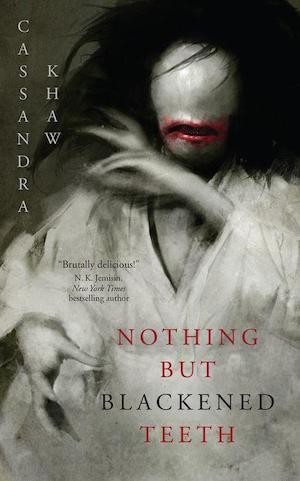

Nothing But Blackened Teeth
Washington, Ellery continues, even wanted to comb the Necronomicon for “terror-weapons” worse than the H-Bomb! Dyer fiercely asserts that neither Feds nor Russians have ever laid a finger on the book. MU maintains sole responsibility over the dreaded tome.
As midnight strikes, narrator rises. It’s now September 15th, anniversary of the Dunwich Horror’s dispersal, and he means to lay the wreath from his cardboard box on Henry Armitage’s grave in the nearby Lich Street cemetery. Wilmarth accompanies him, giving narrator the opportunity to ask if there was a connection between Wilmarth’s encounter with the Plutonians and the Dunwich Horror, both culminating in September 1928. Wilmarth confides that the Plutonians had learned of the Whateleys’ intentions and hoped to block the Ancient Ones’ return. To think that, unknowingly, humanity had brushed “the fringes of an intercosmic war”!
Wilmarth further confides that on March 14, 1937, the Plutonians crept into Rhode Island Hospital where the Young Gentleman from Providence lay dying. There they removed and preserved alive his brain by their usual methods. Now it flies between Hydra and Polaris, “safe in the arms of a night gaunt, reveling forever in the wonders of the universe he deeply loved.”
Narrator shivers at this revelation, but is deeply happy and now respects the formidable Wilmarth even more.
What’s Cyclopean: The moon is gibbous; the roofs are gambreled.
The Degenerate Dutch: There’s something grotesquely clever about Leiber’s casual mention of Arkham’s trees literally degenerating from—Dutch Elm Disease. And there’s something grotesquely un-clever, even with quote-marks, about explaining that the newest “foreigners” in the city are “the Puerto Ricans and the Negroes.” But perhaps the anti-segregation demonstrations on campus are a source of hope.
Weirdbuilding: Leiber provides updates on the Witch House (razed), Miskatonic (improbably maintaining status post-WWII without federal funding), Outer Ones and Old Ones (being surprisingly helpful), Albert Wilmarth (crotchety but in contact with Outer Ones), Daniel Upton (free and designing buildings), the dog that killed Wilbur Whateley (succeeded by a younger dog), Danforth (studying psychology), and several well-known professors (reduced from various adventures to grumping in the faculty club). And of course Lovecraft himself (brain in a jar). Other references and updates abound.
Then there are shoutouts to real-world weird writers Avram Davidson and Damon Knight, as well as Lovecraft disapprovers Edmund and Colin Wilson. The latter’s “The Strength to Dream” is the source of Wilmarth’s ire; he later wrote a Lovecraftian story in response to a challenge from August Derleth.
Libronomicon: It’s a good thing there are only two copies of the Necronomicon, or it might be harder to keep governments from getting access. Better hope no MU grad students go into public service.
Madness Takes Its Toll: Both Upton and Danforth are much mentally-improved from their experiences.
Ruthanna’s Commentary
I was recently invited onto the Fire the Canon podcast to snark about “The Whisperer in Darkness” for their Halloween episode. I reviewed our 2014 post as preparation and was reminded by the comments of the existence of Leiber’s “To Arkham and the Stars” and, well, here we are.
Weird fiction had a bit of a roller coaster across the 20th century, and Mythosian work in particular was relatively sparse during those middle decades. I interrupted my blogging to take a few… let’s say minutes, more time than was probably sensible, to create a spreadsheet tracking publication dates for the stories we’ve covered, and you can easily spot the transition from Lovecraft’s life, to his circle carrying the torch in small presses with minimal connection to non-Mythosian Weird pioneers, to the uptick in interest and participation and as Lovecraft’s stuff becomes more widely available in the internet era. Smack in that mid-century dip, “To Arkham and the Stars” is not so much a game of Spot-the-Reference as a gossipy check-in: how are all our old friends in Arkham doing?
Sitting around the faculty club whinging about what would happen if more people talked about their work, seems to be the answer. Only imagine what might happen if anyone beyond a select circle had access to Miskatonic’s artifacts! It seems, perhaps, symbolic.
This rarity, I suspect, is why Leiber—who certainly did his part to keep the Weird from falling into Mythosian copy-pasting—could cheerfully publish an entire story about how all Lovecraft’s narrators are doing just fine, Arkham’s gotten into atomic physics even as hippies try to summon elder gods, the Outer Ones aren’t so bad, and by the way HP himself is out flying among them. I can absolutely understand why this would be welcome, because I would personally be delighted by a 10-page gossip from any number of series that haven’t updated properly for a couple decades. But in 2021, you can easily find dozens of versions of modern-day Arkham and Miskatonic, conflicting reports on the aftermath of the Innsmouth raid, and new life updates from old narrators. Leiber writes like he’s as close to canon as anyone’s going to get.
There is a wry fondness in Leiber’s updates to Arkham: see, Howard, even your Victorian gambrels must make space for new technologies and new political movements. And a wry pointedness in the direction of new writers: The Witch House has been torn down, maybe it’s time to go beyond re-writing it.
I’m extremely fond of “Whisperer,” and of the Outer Ones’ fine balance between attraction (See the universe! Talk to everyone!) and repulsion (Give up most of your senses! Get carted around in a canister!). I’m also intrigued (and repulsed) by the ways that Lovecraft himself clearly doesn’t sort those things the same way I do, as I consider the canister’s cosmopolitan community one of the perks. So I thought it optimistic of Leiber, or maybe just generous, to believe the Young Gentleman would come around to the pleasures of travel, and that “the wonders of the universe he deeply loved” would win out over his terror of those very wonders.
Anne’s Commentary
Somewhere in the uncaring cosmos, a writer may have produced a Lovecraftian homage that crams in more references per square inch than Leiber’s “To Arkham and the Stars,” for the uncaring cosmos is uncaringly infinite. I’ve yet to meet this prodigy, however, and having been taken to critical task for dropping a solitary “witch-haunted Arkham” into a story, I shudder to imagine the raking-over Leiber would’ve suffered at that reviewer’s hands.
Post-shudders, I reread “To Arkham” with much enjoyment. Leiber deftly balances having a laugh at the Young Gentleman and showing his work a reverence of which even Wilmarth would have approved. The story first appeared in a 1966 Arkham House collection called The Dark Brotherhood and Other Pieces, along with a second Leiber contribution tantalizingly entitled “Through Hyperspace with Brown Jenkin.” Forgive me while I imagine Brown Jenkin taking Chewbacca’s place as Han Solo’s copilot. With Jenkin aboard, the Falcon would have made hyperdrive every time, no problem.
Let’s return to Mythos-haunted Arkham. Leiber knows the capital city of Lovecraft’s fictive Massachusetts as well as any MU alumnus. Tempora mutantur, his narrator thinks: Times are changing, and as the rest of the Roman adage goes, we too change. Arkham has a new airport and freeway and exurban manufacturing sprawl, new suburbs, new housing developments, new underclasses. Its delinquents throw black masses for Fidel Castro, its students demonstrate against segregation; these activities date the story’s action to the early 1960s, I’d say. Tempora mutantur, the Witch House is no more, yet the old essential Arkham must live on while there’s a gambrel roof left in its skyline, a (witch-haunted) island afloat in its river, and a gibbous moon to rise over French Hill.
As befits a Lovecraft tribute, Leiber’s first-person narrator goes unnamed. I think of the narrator as Leiber self-inserted into Lovecraft’s world with an actual tribute in hand. What a tease “Leiber’s” cardboard box is–I expected it to contain something more sinister than a wreath, say some cursed tome or artifact he’d donate to (or unleash upon!) the venerable professorial circle, but I’m not sorry to have my expectations unfulfilled. It’s nice to have one gathering of Mythosian scholars and anti-Eldritch-Horror warriors end without carnage and/or madness. It’s nice, too, that Dyer and Wilmarth don’t class the Antarctic Old Ones and the Plutonians as Eldritch Horrors but rather as allies against both the Ancient Ones and all the humans who must be kept from Knowing Too Much and Abusing that Knowledge, like the Government and Military and certain incautious Scientists. On the other hand, the Peaslees haven’t made emotional peace with the Yith, and Dyer retains his antipathy towards the Shoggoths.
Leiber references most of Lovecraft’s core Mythosian stories. “At the Mountains of Madness,” “The Whisperer in Darkness,” “The Shadow Out of Time,” “The Dreams in the Witch House,” “The Dunwich Horror,” “The Thing On the Doorstep,” and “The Color Out of Space” are well represented. “The Call of Cthulhu” gets oddly scant notice–I recall only a rather labored reference to the old cultist Castro, prompted by an unrelated Castro, that is, Fidel. Left out entirely, per my reading, are “The Shadow Over Innsmouth,” “The Case of Charles Dexter Ward,” and “The Haunter of the Dark.” What the much-cited stories have in common is some connection with Arkham and Miskatonic University. Which makes sense, given Leiber’s setting and professorial cast; “The Shadow Over Innsmouth” is set in that blighted fishing town, “Charles Dexter Ward” and “Haunter of the Dark” in Providence.
I was amused by Leiber’s references to the Wilsons, Edmund and Colin, both of whom issued harsh assessments of the Young Gentleman. Narrator “Leiber” arrives just as Wilmarth’s sending off a scathing refutation of “some whippersnapper’s” critique. I haven’t read Colin Wilson’s The Strength to Dream (1961), so I can’t say whether the objectionable quotes Wilmarth cites are actually from that work. Wilson does call Lovecraft “sick” and “a bad writer” and someone who “rejected reality.” That would have been enough to set Wilmarth off! The publication date of Strength to Dream puts it squarely in “To Arkham’s” timeline, and Wilmarth tells his secretary to mail his refutation to Colin, not Edmund, Wilson. Wilmarth has “taken care of” Edmund in an earlier missive. That would refer to Edmund Wilson’s 1945 article “Tales of the Marvelous and the Ridiculous,” a piece infamous among Lovecraft fans for its evaluation of him as a “hack” and a purveyor of “bad taste and bad art.”
Why does Wilmarth send copies of his refutation to Avram Davidson and Damon Knight? My guesses: From 1962 to 1964, Davidson edited The Magazine of Fantasy and Science Fiction, while Knight was an established SFF critic and reviewer. Wilmarth evidently wants to air his disdain for “the whippersnapper” beyond “the whippersnapper” himself.
That many of Lovecraft’s Mythosian stories are fictionalized nonfiction is a conceit of which I’m fond. I was also delighted to learn from Wilmarth that the Plutonians rescued Howard from oblivion by canning his brain. You go, Mi-Go! My one concern is that Howard might not have chosen a night-gaunt for his can-nanny.
Then again, the Young Gent could surprise one by his eventual embrace of the monstrous, couldn’t he?
Next week, we wrap up John Connolly’s The Fractured Atlas (and possibly the current phase of reality?) with Part V.
Ruthanna Emrys’s A Half-Built Garden comes out in July 2022. She is also the author of the Innsmouth Legacy series, including Winter Tide and Deep Roots. Her short story collection, Imperfect Commentaries, is available from Lethe Press. You can find some of her fiction, weird and otherwise, on Tor.com, most recently “The Word of Flesh and Soul.” Ruthanna is online on Twitter and Patreon, and offline in a mysterious manor house with her large, chaotic household—mostly mammalian—outside Washington DC.
Anne M. Pillsworth’s short story “The Madonna of the Abattoir” appears on Tor.com. Her young adult Mythos novel, Summoned, is available from Tor Teen along with sequel Fathomless. She lives in Edgewood, a Victorian trolley car suburb of Providence, Rhode Island, uncomfortably near Joseph Curwen’s underground laboratory.










